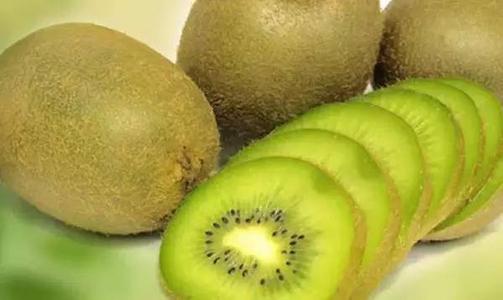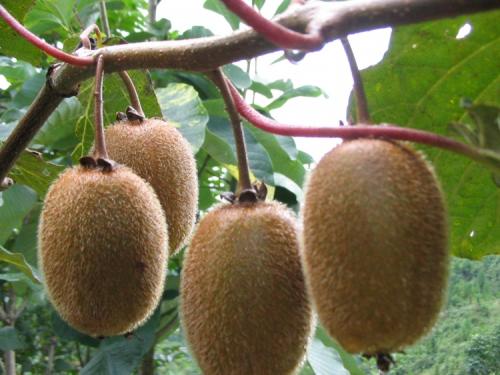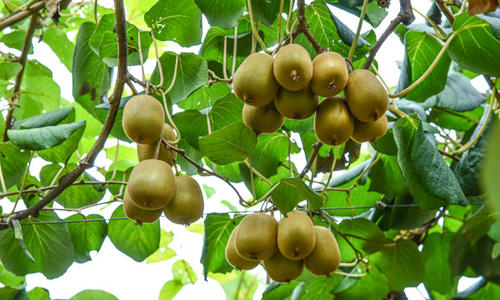Kiwi Profile
Written by lisa
Nov 09 2020

The fruit shape of kiwi is generally oval, the appearance is yellow-brown in the early stage, and reddish-brown when mature, the skin is covered with dense hairs, and the pulp is edible. Inside are bright green flesh and a row of black or red seeds. Because kiwis like to eat, it is named kiwi fruit. It is also said that the skin is covered with hair and it looks like a kiwi. It is a kind of fruit with fresh quality, rich nutrition, and delicious flavor.
Kiwi fruit has a soft texture, sweet and sour taste. The taste is described as a mixture of strawberry, banana and pineapple. In addition to organics such as actinidin, proteolytic enzymes, tannins, pectin, and sugars, as well as trace elements such as calcium, potassium, selenium, zinc, germanium, and 17 amino acids required by the human body, kiwi fruit is also rich in vitamin C and grapes. Acid, fructose, citric acid, malic acid, fat.

The young branch is thick or thin with off-white stellate hairs or brown long bristles or rust-colored bristles. It is bald or has broken hairs in old age; flowering branches are short 4-5 cm, and long 15- 20 cm, 4-6 mm in diameter; the next year the branches are completely bald and glabrous, 5-8 mm in diameter, with oblong lenticels, more or less pronounced, pith white to light brown, lamellar.
Kiwifruit has 3 to 7 sepals, usually 5, broadly ovate to ovoid-oblong, 6-10 mm long, yellowish-brown downy densely compressed on both sides. There are 5 petals, sometimes as few as 3-4 or as many as 6-7, broadly obovate with short claws. Kiwifruit has many stamens, yellow anthers, oblong, 1.5-2 mm long, diverging or not diverging at the base, with a T-shape. Ovary superior, spherical, about 5 mm in diameter, densely covered with golden compacted interwoven villi or unpressed and non-interlaced bristle-like rough hairs, style narrow strips.
The temperature requirements of kiwifruit populations are not very consistent. For example, Chinese kiwifruit grows well at an average annual temperature of 4~20℃, while kiwifruit is the most widely distributed in the range of 13~18℃. The growth and development stage of kiwifruit is also affected by temperature. Studies have shown that when the temperature rises to about 10℃, the young buds of kiwifruit begin to germinate, and can only bloom when the temperature is above 15℃ and can bear fruit when the temperature is above 20℃. When the temperature drops to about 12℃ At that time, it enters the dormant period of fallen leaves, and the entire development process takes about 210 to 240 days, during which the daily temperature cannot be lower than 10 to 12 ℃.
In addition to soil quality and pH, the mineral nutrients in the soil also have an important impact on the growth and development of kiwifruit. Since kiwifruit requires a large amount of nitrogen, phosphorus, potassium and rich elements such as magnesium, manganese, zinc, iron, etc., if the soil lacks these mineral elements, the leaves often show nutritional deficiencies. Therefore, in order to ensure the normal growth and development of kiwifruit, improvement work should be carried out on unsatisfactory soil before planting in the garden, soil testing and formula fertilization, burying a large amount of green manure and a certain amount of lime.
China is the original center of kiwifruit. The origin of kiwifruit in the world is Wuduhe Town, Yiling District, Yichang City, Hubei Province. Kiwifruit is born in forest margins or shrubs on hillsides and is cultivated in some gardens. There are 66 species of Actinidia, 62 of which are naturally distributed in China. The main production and cultivation in the world are Actinidia deliciosa and Actinidia Sinensis. The outer skin of the branches and fruits of Actinidia deliciosa is covered with fluff, and the outer skin of the branches and fruits of Actinidia chinensis is relatively smooth. These two species are mainly distributed in the Yangtze River Basin and Qinling Mountains in Central China and the areas south of them and east of the Hengduan Mountains.
It’s widely distributed in Henan, Jiangsu, Anhui, Zhejiang, Hunan, Hubei, Shaanxi, Sichuan, Gansu, Yunnan, Guizhou, Fujian, Guangdong, Guangxi and other places.
By the early 1970s, kiwi cultivation was still limited to New Zealand, and the cultivation area was not large. Since then, the unique flavor of kiwi fruit has been recognized and welcomed by consumers, so kiwi fruit has developed rapidly worldwide. In addition to New Zealand, Chile, Italy, France, Japan and China are all major kiwifruit producing countries.
Kiwi fruit has a soft texture, sweet and sour taste. The taste is described as a mixture of strawberry, banana and pineapple. In addition to organics such as actinidin, proteolytic enzymes, tannins, pectin, and sugars, as well as trace elements such as calcium, potassium, selenium, zinc, germanium, and 17 amino acids required by the human body, kiwi fruit is also rich in vitamin C and grapes. Acid, fructose, citric acid, malic acid, fat.
Kiwi PicturesKiwi morphological characteristicsCharacteristics of branchesCharacteristics of leavesFlower characteristicsFruit characteristicsKiwi growth habit and growing environment and distributionTemperatureMoistureIlluminationSoilKiwi efficacy and roleThe ornamental value of the kiwiThe therapeutic value of the kiwi
Kiwi Pictures


Kiwi morphological characteristics
Kiwi is a dioecious, large deciduous woody vine. The male plants have hairy leaves and small leaves, and the flowers of the male plants appear earlier in the female flowers; the female plants are less or glabrous, and the mosaic leaves are larger than the male plants. The flowering period is from May to June, and the fruit ripening period is from August to October.Characteristics of branches
The branches of kiwi are brown, pilose, white pith, and lamellar.The young branch is thick or thin with off-white stellate hairs or brown long bristles or rust-colored bristles. It is bald or has broken hairs in old age; flowering branches are short 4-5 cm, and long 15- 20 cm, 4-6 mm in diameter; the next year the branches are completely bald and glabrous, 5-8 mm in diameter, with oblong lenticels, more or less pronounced, pith white to light brown, lamellar.
Characteristics of leaves
The leaves of kiwifruit are paper, without stipules, obovate to obovate or broad ovate to nearly round, 6-17 cm long, 7-15 cm wide, truncated at the top and concave in the middle or with a sharp point. Point to a short acuminate, blunt round base, truncated to shallow heart-shaped, straight ciliary small teeth with pulsed edges, dark green ventral surface, hairless or a small amount of soft hair or scattered short on the midrib and lateral veins Coarse, pale green on the back, densely covered with off-white or light brown stellate villi, 5-8 pairs of lateral veins, often branching into forks above the middle, relatively developed transverse veins, easy to see, reticulate veins are not easy to see; petiole is long 3-6 (-10) cm, with grayish-white hairs or yellowish-brown long bristles or rust-colored bristles.Flower characteristics
The flowers of kiwifruit are cymes 1-3 flowers, inflorescence stalk length 7-15 mm, flower stalk length 9-15 mm; bracts are small, ovate or diamond-shaped, about 1 mm long, all covered with off-white filamentous hairs or Yellow-brown hairy; milky white when the flowers bloom, and then turn pale yellow, fragrant, 1.8-3.5 cm in diameter, solitary or several in the leaf axils.Kiwifruit has 3 to 7 sepals, usually 5, broadly ovate to ovoid-oblong, 6-10 mm long, yellowish-brown downy densely compressed on both sides. There are 5 petals, sometimes as few as 3-4 or as many as 6-7, broadly obovate with short claws. Kiwifruit has many stamens, yellow anthers, oblong, 1.5-2 mm long, diverging or not diverging at the base, with a T-shape. Ovary superior, spherical, about 5 mm in diameter, densely covered with golden compacted interwoven villi or unpressed and non-interlaced bristle-like rough hairs, style narrow strips.
Fruit characteristics
The kiwi fruit is ovoid in shape and has a cross-sectional radius of about 3 cm. It is densely covered with yellow-brown branched pilose. It is about the same size as a duck egg and is generally oval in shape. The dark brown and hairy skin is generally not edible. Inside are bright green flesh and rows of black seeds.
Kiwi growth habit and growing environment and distribution
Temperature
Temperature is the main factor restricting the distribution and growth of kiwifruit. Each species has a suitable temperature range. If it exceeds this range, it will grow poorly or cannot survive. Most species of kiwi require a warm and humid climate, that is, subtropical or temperate humid and semi-humid climate. They are mainly distributed in the vast area of 18-34 degrees north latitude. The annual average temperature is about 11.3~16.9℃, the extreme maximum temperature is 42.6℃, and the extreme minimum temperature. About 1-20.3℃, the effective accumulated temperature above 10℃ is 4500~5200℃, and the frost-free period is 160~270 days.The temperature requirements of kiwifruit populations are not very consistent. For example, Chinese kiwifruit grows well at an average annual temperature of 4~20℃, while kiwifruit is the most widely distributed in the range of 13~18℃. The growth and development stage of kiwifruit is also affected by temperature. Studies have shown that when the temperature rises to about 10℃, the young buds of kiwifruit begin to germinate, and can only bloom when the temperature is above 15℃ and can bear fruit when the temperature is above 20℃. When the temperature drops to about 12℃ At that time, it enters the dormant period of fallen leaves, and the entire development process takes about 210 to 240 days, during which the daily temperature cannot be lower than 10 to 12 ℃.
Moisture
Kiwifruit is a fruit tree that needs water but is afraid of flooding. It is a fruit tree with weak physiological drought tolerance and weak moisture tolerance. Therefore, the requirements for soil moisture and air humidity are relatively strict, which determines that kiwifruit is most suitable for abundant rainfall and uniform distribution, high air humidity, Cultivated in humid but not waterlogged areas. The annual rainfall in the natural distribution area of kiwifruit in China is 800 mm-2200 mm, and the relative air humidity is 74.3%-85%. Generally speaking, areas where the annual precipitation is between 1,000 mm and 2,000 mm and the relative humidity of the air is around 80% can meet the water requirements for the growth and development of kiwifruit. If the annual average precipitation is 500 mm, then it is necessary to consider setting up irrigation facilities to prepare for irrigation during drought. There is more fog in high mountains, moist soil on both sides of streams, and high humidity all year round, which is ideal for the growth of kiwifruit. In the central and eastern regions, there is sufficient rain from April to June, and the shoots grow in large quantities, which are suitable for the growth requirements of kiwifruit.Illumination
Most kiwifruit species like a semi-shady environment, they like sunlight but are more sensitive to strong light. They belong to medium light-loving fruit tree species, requiring the sunshine time of 1300-2600 hours, like diffuse light, to avoid direct sunlight. The resultant plants require a certain amount of light, and the natural light intensity is preferably 42%-45%.
Soil
The soil is deep, fertile, good air permeability, groundwater level below 1 meter, high organic matter content, and slightly acidic sandy soil with a pH of 5.5-6.5. A strong acid or alkaline soils need to be improved before cultivation.In addition to soil quality and pH, the mineral nutrients in the soil also have an important impact on the growth and development of kiwifruit. Since kiwifruit requires a large amount of nitrogen, phosphorus, potassium and rich elements such as magnesium, manganese, zinc, iron, etc., if the soil lacks these mineral elements, the leaves often show nutritional deficiencies. Therefore, in order to ensure the normal growth and development of kiwifruit, improvement work should be carried out on unsatisfactory soil before planting in the garden, soil testing and formula fertilization, burying a large amount of green manure and a certain amount of lime.
China is the original center of kiwifruit. The origin of kiwifruit in the world is Wuduhe Town, Yiling District, Yichang City, Hubei Province. Kiwifruit is born in forest margins or shrubs on hillsides and is cultivated in some gardens. There are 66 species of Actinidia, 62 of which are naturally distributed in China. The main production and cultivation in the world are Actinidia deliciosa and Actinidia Sinensis. The outer skin of the branches and fruits of Actinidia deliciosa is covered with fluff, and the outer skin of the branches and fruits of Actinidia chinensis is relatively smooth. These two species are mainly distributed in the Yangtze River Basin and Qinling Mountains in Central China and the areas south of them and east of the Hengduan Mountains.
It’s widely distributed in Henan, Jiangsu, Anhui, Zhejiang, Hunan, Hubei, Shaanxi, Sichuan, Gansu, Yunnan, Guizhou, Fujian, Guangdong, Guangxi and other places.
By the early 1970s, kiwi cultivation was still limited to New Zealand, and the cultivation area was not large. Since then, the unique flavor of kiwi fruit has been recognized and welcomed by consumers, so kiwi fruit has developed rapidly worldwide. In addition to New Zealand, Chile, Italy, France, Japan and China are all major kiwifruit producing countries.
Kiwi efficacy and role
The ornamental value of the kiwi
The vines of kiwifruit are twisted and twisted, with dense branches and leaves, beautiful and fragrant flowers, suitable for vertical greening of flower stands, courtyards, guardrails, walls, etc.The therapeutic value of the kiwi
Kiwi fruit is rich in minerals, including rich calcium, phosphorus, iron, carotene, and multiple vitamins, which play an important role in maintaining human health.Latest Updated
- Benefits of Bugleweed - 7 Science-backed Health Benefits
- Bugleweed Dangers & Side Effects - Is It Poisonous?
- How to Plant Evergreen Trees - What You Should Know
- When to Plant Evergreens - Grow Guide for Evergreen Trees
- 12 Wonderful Evergreen Shrubs for Your Garden
- 12 Popular Evergreen Plants with Pictures for Beginners
- When And How To Prune A Lilac Bush Like a Pro
- How to Grow & Care for Lilac Vine (Hardenbergia Violacea)
- Japanese Lilac Tree (Syringa Reticulata) Care & Propagation Guide
- Shumard Oak Pros and Cons - What to Know
Popular Articles
- Winter maintenance of Antirrhinum Majus
- How to Grow Terminalia Mantaly Tree
- How to Grow and Care for Crossostephium Chinense
- How to grow Antirrhinum Majus in spring
- Peristeria Elata (Dove Orchid) Profile: Info & Care Guide
- Underwatered Snake Plant (Sansevieria Trifasciata) - Signs And How To Fix
- How to Care for Brazilian Jasmine Plant (Mandevilla Sanderi)
- How to Grow & Care for Graptopetalum Purple Delight in Summer
- Rosa Chinensis (China Rose): Plant Growing & Care Tips
- How to Care for Baby Sun Rose (Aptenia Cordifolia)